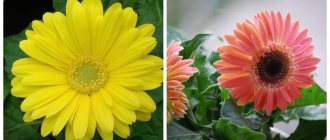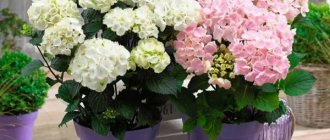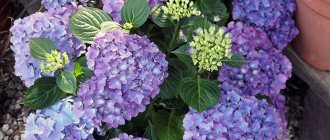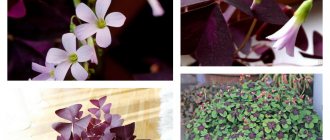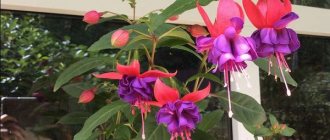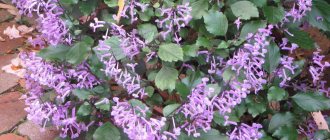Garden gerbera - what kind of flower is it, what family does it belong to?
Gerbera belongs to the Astrov family. The plant is characterized by a powerful root system; the height can reach 20-30 centimeters. Thick green leaves are collected in a neat rosette, above which the flower stalks rise.
Flower growers compare gerberas with echinacea or daisies. The difference is a wider range of colors
The average diameter of the inflorescence is 12 cm. It can bloom for 30 days. At the same time, the gerbera itself blooms for three months. During this time, up to two dozen flowers are formed on a compact bush. They are large, solitary, with a light-colored basket core. Flowers can be regular, double or semi-double.
Brief description, origin story
The gerbera is native to South Africa. Grows in the wild. Scientists talk about two versions of the origin of the name of the flower. According to one of them, the gerbera received its name in honor of Traugott Gerber, a doctor and biologist from Germany, who for many years worked in Russia and headed the apothecary botanical garden in Moscow. The second version says that from Latin the word “coat of arms” can be translated as “grass”, and since this plant belongs to the herbaceous group, it could have been given this name.
Additional Information! It was a breeder from Scotland who first noticed the bright flower: it was he who first started cultivating gerberas. This happened in one of the French provinces - Transvaal, and therefore gerbera has another name - Transvaal chamomile.
Fertilizers
It is not recommended to use organic matter for feeding. Because it can cause various fungal diseases.
A complex mineral fertilizer for flowering plants is best suited. You can buy it at any flower shop. When the gerbera begins to grow green mass, it needs nitrogen-containing fertilizers, but when the buds bloom, you need to use fertilizers that contain calcium and potassium. It is thanks to the latter that flowering will be longer and more abundant.
Feeding should be done once every two weeks.
Plant varieties, popular tall varieties, what they look like
Gerbera flower garden planting and care in open ground
Despite the wide variety of species and varieties (more than 1000 varieties have been bred to date), breeders continue to work on developing new ones. Gardeners prefer hybrids and varieties that are characterized by high decorative qualities. It is worth considering the most popular varieties of gerberas that are suitable for growing in open ground.
Gerber Jameson
This variety is called the main one. It was on its basis that all species known to gardeners today were bred. The Jameson's gerbera flower is located on a strong, thick stem of medium height; the leaves are large, pubescent, and feathery in shape. Inflorescences, the diameter of which exceeds 10 centimeters, have one or several rows of petals, the total number of which usually reaches 30. The color palette is varied, with the middle of the flower contrasting with the main tone. The flowering time of one flower is 21 days.
Gerber Wright
Gerbera Wrighta is usually grown to create bouquets and as an important component of landscape design. The plant has a long flowering period - it begins in the spring and continues until the onset of cold weather. The rosette consists of large feathery leaves, at the end of a long peduncle a flower is formed, more like a chamomile. The center is usually yellow or white, the petals can be of different shades:
- red;
- purple;
- yellow;
- orange;
- pink.
Most often, Wright's gerbera is used to create bright and original bouquets.
Gerbera abyssinica
This plant is more similar to medicinal chamomile than others. Found in the wild in Ethiopia. The flowers are reed-type, most often white. Young foliage has slight pubescence. The basal rosette consists of elliptical leaves.
Additional Information! Often gardeners have a question: is gerbera a perennial or annual plant? As a houseplant, the flower is grown as a perennial, but when grown outdoors in cold climate regions, it is more often cultivated as an annual flower.
Gerbera Alcor
The variety is ideal for growing outdoors. It is a small flower with narrow leaves, whose flowers are characterized by a dense cherry color. The average height of the plant reaches 60 cm.
Aldebaran and others
A narrow-petalled variety with small flowers of a pleasant pink hue. The average diameter of the inflorescences rarely exceeds 9 cm. The height of the bush varies from 50 to 60 cm. Other varieties are also popular among gardeners - gerberas are grown in dachas and gardens:
- terry and semi-double - for example, Iskra;
- large-flowered with petals of medium size - Mars;
- narrow-petaled with large flowers - Jupiter and Migar;
- broad-petaled inflorescences of small or medium sizes - Vera and Saturn.
general information
Gerbera is a perennial plant that you will probably recognize by its long stem with a large, bright flower. The rosette of leaves spreads out to the sides near the ground, and the peduncle extends upward by 60 cm. The basket inflorescences reach up to 15 cm in diameter, for which they are highly valued by flower growers and florists.
Although gerbera is common in all our flower shops and markets, in fact it is an exotic guest. In nature, it grows in Africa, in tropical and subtropical latitudes. Despite this, the flower has taken root well here too.
Photo: my.mail.ru
Planting garden gerbera in open ground
What are gerbera flowers - what they look like and how they grow
Even short-term cold snaps can destroy a garden gerbera. Therefore, the best time to plant a flower in a permanent place in open ground begins after the threat of frost has passed.
Note! Experienced gardeners recommend planting gerberas at the same time as tomatoes, eggplants, and cucumbers.
Selecting a location
One of the most important factors necessary for the full development of a plant is the correct choice of location. The fact is that the plant will not bloom if it is planted in an area where there is not enough lighting. In addition, the place should be closed from wind and draft.
Important! In open ground, gerberas can grow either in the south of Russia or in the middle zone. Residents of other regions will have to prepare a place in the greenhouse for the plant.
How to prepare soil and seedlings for planting
The main difference between gerberas and other garden crops is that they will not grow in waterlogged soil; large chamomile does not like clay soil. It is important that the place for planting the flower is rich in magnesium, potassium and manganese. Experienced gardeners warn: when preparing soil for gerberas, you should not add any type of manure to it. Instead, add a small amount of compost.
Plants must be provided with sufficient lighting, otherwise the peduncles will stretch out and the flowers will be small
Before planting gerbera seedlings in the country, prepare the seedlings. First, it should be examined. There should be no white coating, brown or yellowish-brown spots on it. It should not be elongated. The normal leaf color is deep green. In order for the seedlings to adapt to new conditions, they must be taken outside for the whole day.
Lighting
Gerberas really respect direct sunlight. This is a prerequisite for the formation of a lush crown of leaves and flowering. Only, if the flower is on a south window, it is better to protect it with a curtain or blinds at midday.
The optimal length of daylight for comfortable maintenance of gerbera throughout the year is at least 12–13 hours. Therefore, from approximately mid-autumn to mid-spring, we recommend illuminating the flower to these levels using conventional fluorescent, LED or special phytolamps, placing them at a slight angle at a distance of about 80 cm above the pot. Sufficient lighting is a necessary condition for flowering.
How to care for perennials
Speaking about how to grow gerberas, one cannot help but say that the culture loves fresh air, is demanding of bright lighting, moderate humidity levels, and timely application of fertilizing.
Watering rules and humidity
Fuchsia growing and care in the garden, in open ground
The culture prefers small but frequent watering. During the growing season, garden gerberas require more water, but it is important to ensure that there is no stagnation of moisture at the roots.
A number of rules must be followed:
- water should not get on the socket;
- Avoid getting water on the leaves;
- use only warm water - 26-28 ℃ above zero.
Important! Experienced gardeners recommend the following watering scheme: four days of moist soil should be followed by two days of dry soil.
For any gerbera in the garden, cultivation and care should be as close as possible to the natural conditions of warm countries. Flower growers note: it is not advisable to spray gerberas, but the level of air humidity should be high - about 65-75%, but should not exceed 85%.
The optimal soil for the crop is weakly acidic.
Before planting a gerbera, the place for it should be treated with phytosporin to prevent fungal diseases.
Fertilizing and soil quality
30 days after transplanting the flower to a permanent place, you can apply the first fertilizers to the soil. Flower growers recommend applying mineral fertilizers once every 14 days from March until autumn.
Organic products are prohibited. Flowers will react negatively to compositions that contain chlorine, cow or bird manure. Because of such fertilizers, root collar rot may develop and the plant will die.
Pruning and replanting
After the plant has flowered, it is necessary to carry out the pruning procedure. Dry leaves and flower stalks on which the flowers have already faded should be removed. It will not be superfluous to trim off excess leaves - this is necessary to stimulate new flowers.
It is best to replant gerberas in the spring. The soil should be light and drained. The roots should be trimmed, leaving only 10-15 cm. Before replanting, the root collar of the plant should be treated with a slightly pink solution of potassium permanganate.
Temperature
The optimal temperature during the growing season and flowering is considered to be 20–25 degrees. in the daytime and 18-20 degrees. at night. This corresponds to natural indicators in its homeland. During the winter holidays, the temperature in the room is reduced to 14–16 degrees, while reducing the watering rate. At 12 gr. In warm temperatures, gerberas go into “hibernation”: almost all processes slow down, flowering is excluded. Temperature 8-10 degrees. is critical for home gerbera, although in its native places it can withstand lower temperatures due to the fact that the roots there are, after all, in warmer and more humid layers of soil.
The flower does not like sudden changes in temperature, especially during flowering. The heat is 30 degrees. Gerbera also does not tolerate higher levels well - the inflorescences quickly wither, the leaves lose their tone. On such days, remove the flower to cooler places, shade it, and ventilate the premises more often.
Caring for gerberas in winter
Breeders have managed to develop varieties that can withstand temperatures down to -10 ℃, but they also need shelter for the winter.
Speaking about whether gerbera is a perennial or an annual, it should be said that everything depends on the climatic conditions of the region. In regions where winters are harsh, it is recommended to transplant the plants into containers - and move them indoors. At home, plants will definitely survive the winter. In the southern regions, it is enough to trim the flower stalks, stop applying fertilizers, and reduce watering. Before winter, bushes should be covered with straw and fallen leaves.
Flower growers advise placing pots with gerberas in rooms with low air humidity and stable temperatures
Air humidity
Gerbera does not tolerate dry air well. The optimal humidity level for it is 70–80%. If the indicators are greatly reduced, especially during the heating season, the humidity must be increased by all available means. It is not advisable to spray the plant itself - neither the leaves nor the flowers like it. But regularly spraying the space surrounding the flower, creating a water suspension or fog around the gerbera, is very necessary. There are other ways to increase indoor humidity, for example:
- place the pot in a deep tray, at the bottom of which is a layer of wet expanded clay, pebbles, sphagnum moss or coconut fiber;
- cover the radiators with wet towels;
- create a gerbera “company” of other plants that evaporate moisture from the leaves;
- Place wide containers of cool water around the gerbera;
- Buy a household humidifier and use it.
If the humidity in the room, on the contrary, is too high, above 80-85%, this will make the gerbera vulnerable to fungal and other infections, especially in winter. In this case, ventilation, reducing the amount of watering, and canceling spraying will help.
Flower propagation methods
The plant can be propagated in several ways. The main ones are by dividing the bush and seeds.
Reproduction by dividing the bush
In early spring, you need to dig up a bush and divide it into several shoots. Each one should have leaves. The shoots should be planted in the ground so that the rosette protrudes no more than a centimeter.
Propagation by seeds
Speaking about how to get bright gerbera flowers, how to grow them from seeds, one cannot help but say that this process is energy-consuming. Already in January-February, seedlings are planted. The seeds are soaked in water, never allowing them to dry out. After 4-5 days, when the seeds begin to hatch, they are moved to moist, loose soil. The soil is sprinkled with sand on top and covered with film. From time to time the soil is moistened - it is best to do this with a spray bottle. In a week the first shoots will appear.
Bloom
Perennial garden gerbera begins to bloom with the onset of summer, and this process does not stop until it ends. It is better to just admire the bright blooms and not try to collect a bouquet, as this can have bad consequences. The flower must not just be plucked, but directly unscrewed from the leaf rosette. If even a small piece of the stem remains there, the plant may rot, which will later lead to its death.
Growing problems, diseases and pests
Most often, gerberas are susceptible to fungal diseases. If the fungus has infected the root system of the plant, the flower should be transplanted to a new location, having previously treated the soil and roots of the plant with antifungal drugs. The drugs will also help get rid of gray rot.
Additional Information! Fungicides will help in the fight against powdery mildew. If the root collar begins to rot, you should reduce watering and begin to loosen and mulch the soil.
Among the most common causes leading to the disease, experts identify:
- excessive watering - because of it, fusarium and late blight develop;
- lack of moisture – leads to the appearance of spider mites;
- aphid attacks - the plant begins to wither.
To prevent gerbera leaves from turning pale, they should be shaded on sunny days.
Gerbera may stop blooming when it doesn't get enough sunlight or the soil contains too much nitrogen. If the leaves begin to turn yellow and dry out, the plant is not getting enough moisture.
Gerbera daisies can become a gardener's real pride and the main decoration of the garden - all you need to do is know how to properly plant seedlings in a permanent place and how to care for them. All the efforts and time spent will certainly be worth it - the gerbera will delight you with lush flowering and a real riot of colors.
What kind of pot do you need?
The diameter of the pot should not be too large, only 2–3 cm wider than the root system of the flower. Crowding in a pot is one of the conditions for abundant flowering of gerberas. Volume - approximately 1–1.5 liters.
A deep pot made of unglazed ceramics is best suited for gerberas - this will allow air to pass well to the roots of the plant. But in winter, on a cold windowsill, the roots of the gerbera in such a pot can become hypothermic. This should not be allowed, because gerbera is very sensitive to this. In this case, foam or a wooden stand under the pot for thermal insulation will help.
